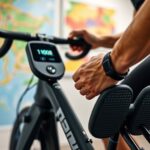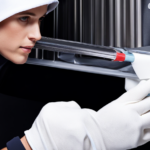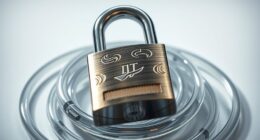To keep your indoor trainer running smoothly, regularly clean and wipe down after workouts to remove sweat and dust. Inspect moving parts, belts, and electrical connections for wear or corrosion, lubricating and replacing as needed. Maintain a stable environment by controlling humidity and using fans or dehumidifiers. Proper storage and cable organization help prevent damage, and calibration ensures accurate resistance. Keep up with routine checks, and you’ll extend your trainer’s lifespan—there’s more you can do to optimize its performance.
Key Takeaways
- Regularly clean your trainer and environment to prevent dust, sweat, and debris buildup, especially in dusty areas like garages.
- Inspect and lubricate moving parts, belts, and electrical connections to prevent corrosion and ensure smooth operation.
- Use a trainer mat and maintain proper ventilation to control humidity and protect against rust and moisture damage.
- Calibrate your trainer periodically and replace worn components like belts, chains, and sensors for accurate resistance.
- Store your trainer in a dry, climate-controlled space and organize cables to prevent damage during use and downtime.
Keep Your Training Area Clean and Environment Stable

Keeping your training area clean and environment stable is essential for maintaining your indoor trainer’s performance and longevity. To do this, guarantee your training area is free of dust, dirt, and debris that can interfere with moving parts. Regularly vacuum and dust the space, especially in dusty environments like garages. Keep the environment dry and climate-controlled to prevent moisture and humidity from causing rust or corrosion. Using a trainer mat or wall can protect cables and components from damage, sweat, and debris. Good ventilation with fans or dehumidifiers helps reduce moisture buildup, further preventing rust. Maintaining a clean environment is a key part of trainer maintenance, helping your equipment run smoothly and last longer, while also creating a safe, effective workout space. Additionally, monitoring environmental factors such as humidity and temperature can prevent premature wear of your trainer’s components. Implementing proper equipment storage practices can further extend the lifespan of your trainer by avoiding unnecessary exposure to damaging elements. Proper air circulation can also help in maintaining an optimal environment for your trainer. Ensuring proper headphone setup and maintenance can also enhance your workout experience by providing clear audio and reducing distractions. Regularly inspecting your trainer for signs of rust or corrosion and addressing issues promptly will preserve its condition over time.
Regularly Wipe Down and Clean Your Trainer

After each workout, wipe down your trainer with a soft, damp cloth to remove sweat, dust, and grime that can cause corrosion. Use mild cleaning agents or disinfectant wipes designed for electronics and metal parts to avoid damage. Pay close attention to areas like the flywheel, resistance unit, and sensors to keep your trainer in top shape. Regular cleaning helps mitigate the risk of corrosion and bias, ensuring safer and more reliable performance over time. Additionally, avoid using harsh chemicals that could damage sensitive components and impair the air quality of your workout space. Proper maintenance of these components can also prevent the buildup of residues that may affect performance accuracy. Being mindful of virtual affairs and digital interactions can also help maintain a trustworthy environment, especially in shared spaces or when sharing equipment.
Dust and Sweat Removal
Have you noticed how sweat and dust can quickly accumulate on your indoor trainer? Regularly wiping it down with a damp cloth or disinfectant wipes helps keep dust, sweat, and debris off the surface. This simple maintenance prevents corrosion and keeps your trainer running smoothly. Pay close attention to metal parts, electrical components, and moving joints, as sweat and dust buildup in these areas can cause malfunctions or damage. Use a soft brush or compressed air to clean dust from sensors, vents, and crevices where dirt tends to gather. Incorporating regular maintenance checks can further ensure your trainer remains in optimal condition. Regular cleaning after each workout helps prevent the corrosive salts from sweat from degrading metal and electronic parts. Understanding trainer maintenance can further enhance your equipment’s longevity and performance. Additionally, being aware of sound vibrations and their effects can help you choose quieter, more efficient trainers for your home gym. Proper dust management can significantly reduce wear and tear on sensitive components, extending your trainer’s lifespan. Maintaining a clean trainer not only prolongs its lifespan but also ensures accurate power output and peak performance.
Proper Cleaning Techniques
To guarantee your indoor trainer remains in top condition, it’s vital to clean it regularly using proper cleaning techniques. After each ride, wipe down all surfaces with a soft, damp cloth or microfiber towel to remove sweat, dust, and debris. For stubborn dirt or grime, use a mild soap solution, avoiding harsh chemicals that could damage electronic components. Pay special attention to moving parts like belts, rollers, and bearings, since dirt buildup can impair performance. Regular cleaning helps prevent rust and corrosion, especially on metal and electrical elements. Disinfect contact points such as handlebars, consoles, and knobs with disinfectant wipes or alcohol-based cleaners to maintain hygiene. Incorporating proper maintenance practices can extend the lifespan of your equipment and ensure consistent performance. To further protect your trainer, consider applying a protective coating designed for electronic devices, which can help repel dust and moisture. Additionally, staying informed about industry transformations can help you adopt new techniques for better equipment care. Always allow your trainers to dry completely before storage or use to guarantee optimal functioning.
Inspect and Maintain Moving and Electrical Parts

Start by inspecting electrical connections for corrosion, loose wires, or damage to keep your trainer functioning accurately. Then, check moving parts like hinges and bearings, lubricating them as recommended to prevent wear. Finally, verify all electrical components are clean and secure to avoid issues during your workouts.
Check for Corrosion Signs
Regularly inspecting your indoor trainer for signs of corrosion is essential to guarantee its longevity and peak performance. Corrosion can develop on metal components like trainer legs, cassette lockrings, and electrical contacts due to moisture exposure. To keep everything in top shape, follow these steps:
- Inspect metal surfaces for rust, discoloration, or white/greenish powdery deposits, which indicate corrosion from sweat or humidity. Moisture exposure can accelerate corrosion if not properly managed. Using appropriate protective coatings can further help prevent metal deterioration.
- Check electrical connectors and sensors for signs of oxidation or corrosion, and clean them with contact cleaner if needed. Understanding material durability helps in selecting the best cleaning methods and maintenance routines.
- Examine moving parts such as bearings and drive belts for signs of wear or rust, replacing parts if corrosion is present.
- Proper storage in a dry, well-ventilated space helps prevent ongoing corrosion and electrical issues, ensuring your indoor cycling equipment remains in optimal condition.
Lubricate Moving Components
Inspecting and lubricating your indoor trainer’s moving and electrical parts is essential for maintaining smooth operation and extending its lifespan. Regularly lubricate moving parts like belts, bearings, hinges, and joints using manufacturer-approved oils or greases. Applying a small amount of lubricant every 10-15 hours of use helps reduce friction and prevents premature wear. Proper care also involves lightly lubricating electrical connectors and sensors to prevent corrosion and ensure reliable data transmission. Be cautious not to over-lubricate, as excess oil can attract dust and dirt, leading to faster deterioration. Regular trainer maintenance of these components keeps your indoor trainer running smoothly, reduces squeaks, and maintains peak performance. Consistent lubrication is key to preventing stiffness and ensuring long-lasting, trouble-free operation. Additionally, checking for beneficial ingredients in lubricants can help optimize your maintenance routine and protect sensitive parts.
Inspect Electrical Connections
Maintaining your indoor trainer’s electrical connections is essential for reliable performance and safety. Regular inspections help prevent issues that can disrupt your workout. Start by examining all electrical cables and connectors for signs of corrosion, damage, or wear. Pay close attention after intense or prolonged sessions. Next, ensure that all contact points and sensors are clean, using isopropyl alcohol and a soft cloth to remove dust or sweat buildup. Finally, verify that connections are tight; loose plugs or terminals can cause connectivity problems. Remember to update firmware as recommended by the manufacturer to sustain sensor accuracy and responsiveness. By consistently inspecting and maintaining your electrical connections, you reduce the risk of malfunctions and ensure your trainer operates smoothly and safely.
Check for Wear and Replace Worn Components

To keep your indoor trainer functioning smoothly, you need to check for signs of wear on key components. Regular maintenance involves inspecting drive components like belts and chains for cracks, stretching, or slipping. Use a chain wear checker to determine if your chain has elongated beyond 0.5-0.75%, signaling it’s time to replace. Worn components can cause noise, roughness, or inefficiency, so replace them promptly. Check bearings and pawls for looseness or noise; replace if necessary. Also, examine electrical connectors and sensors for corrosion or damage, replacing faulty parts immediately. Keeping these components in check ensures smooth operation and prolongs your trainer’s lifespan.
| Component | Signs of Wear |
|---|---|
| Chain | Stretching, elongation, slipping |
| Drive belts | Cracks, cracks, slipping |
| Bearings | Noise, roughness, looseness |
| Pawls | Looseness, noise |
| Electrical parts | Corrosion, damage |
Manage Sweat and Humidity to Prevent Corrosion
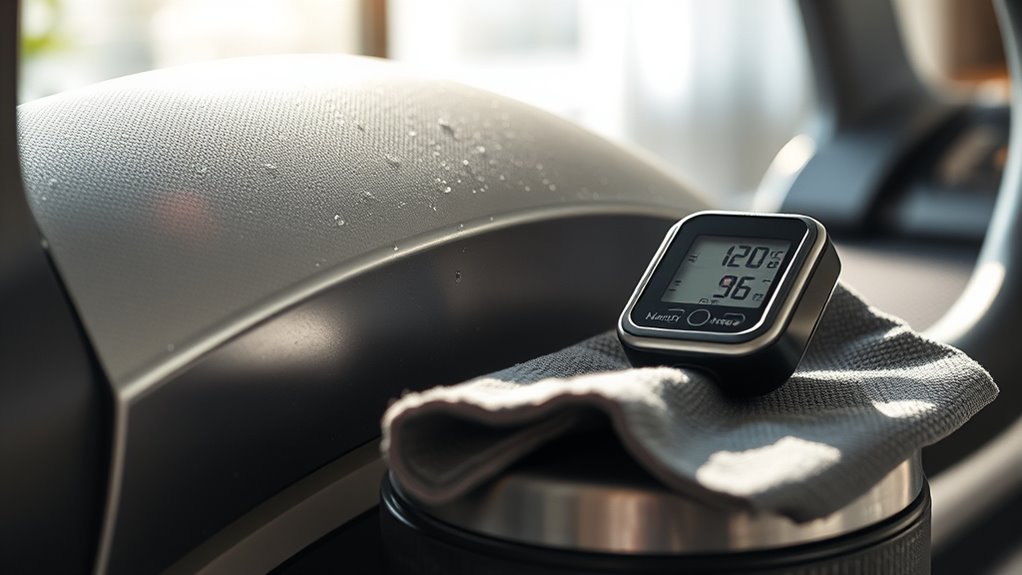
Since sweat can quickly cause corrosion on metal and electrical components, managing humidity and moisture levels is essential for protecting your indoor trainer. To prevent damage, consider these steps:
- Use fans, dehumidifiers, and proper ventilation to reduce humidity, limiting rust and corrosion on metal components.
- After each session, wipe down your trainer with a dry or slightly damp cloth to remove sweat residue and prevent buildup.
- Apply protective coatings or corrosion inhibitors on exposed metal surfaces to create a barrier against moisture and sweat-induced damage.
Storing your trainer in a dry, well-ventilated area and using covers during intense sessions further minimizes humidity exposure. Proper trainer maintenance ensures longevity and ideal performance, safeguarding against corrosion.
Properly Lubricate and Calibrate Your Trainer
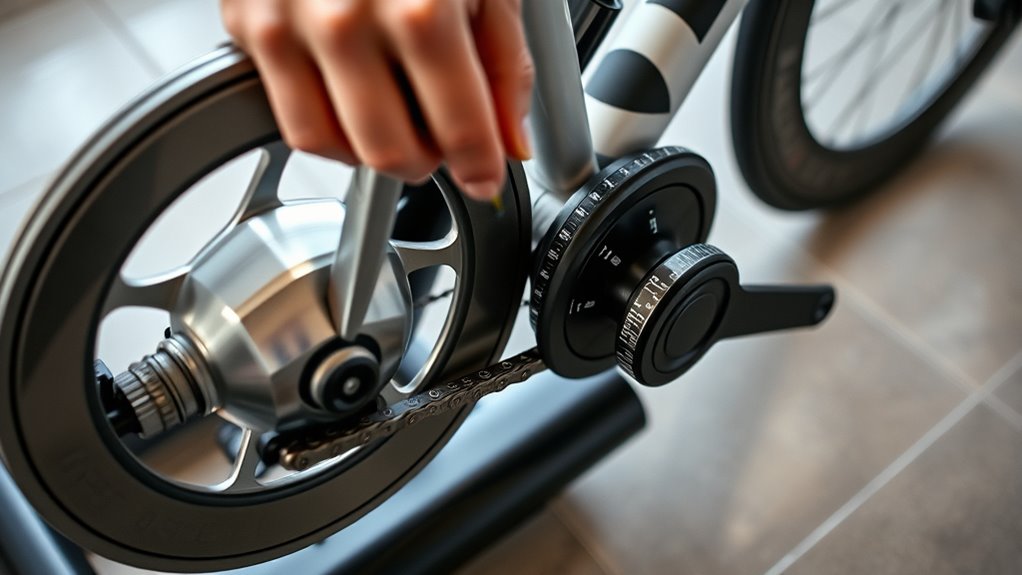
After wiping down your trainer to remove sweat and prevent corrosion, it’s important to keep its moving parts working smoothly by properly lubricating and calibrating them. Use manufacturer-approved lubricants to properly lubricate the drive belt, hinges, rollers, and bearings, applying sparingly to prevent dirt buildup. Regularly calibrate your trainer with the calibration device or app to ensure accurate resistance and power readings. This helps maintain trainer maintenance and prevents premature wear of components. Focus on lubricating the drive belt or chain at recommended intervals, usually every 20-50 hours of use or when noise increases. Proper calibration guarantees peak performance and accuracy. By following these steps, you extend your trainer’s lifespan and keep your indoor workouts consistent and reliable.
Protect Cables and Sensitive Electronics
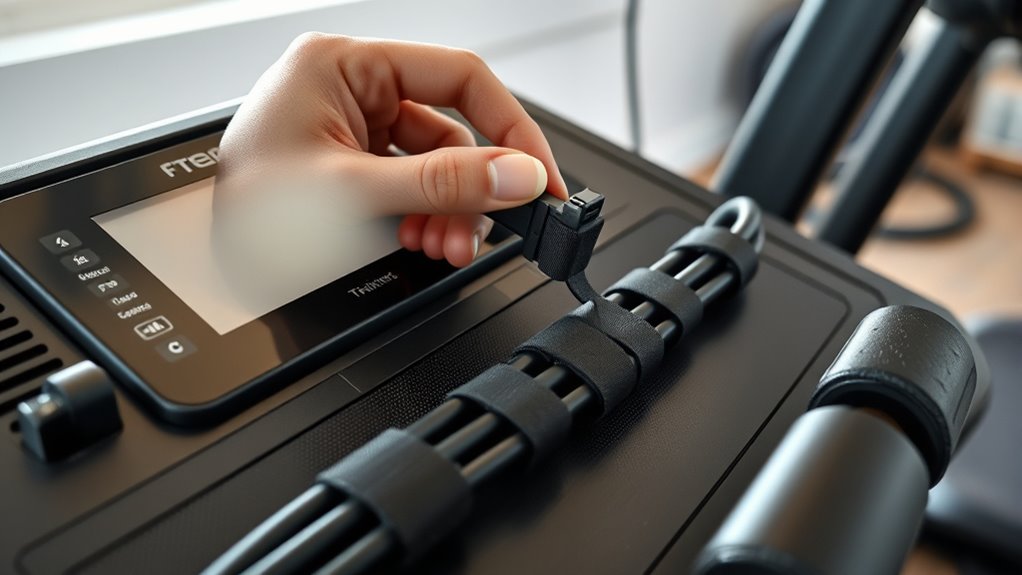
Protecting your cables and sensitive electronics from damage is essential for maintaining your trainer’s reliable performance. To do so, follow these steps:
- Regularly inspect cables and connectors for signs of wear, fraying, or damage. Replace any compromised cables immediately to prevent electrical failures.
- Keep cables and connectors clean by wiping them with a soft, damp cloth, avoiding harsh chemicals, and removing dust, sweat, and debris.
- Organize and secure cables using cable ties or clips to prevent accidental pulls, trips, or damage during workouts. Also, protect electronics from moisture by avoiding damp environments and storing cables properly when not in use.
Follow Manufacturer Guidelines for Routine Servicing
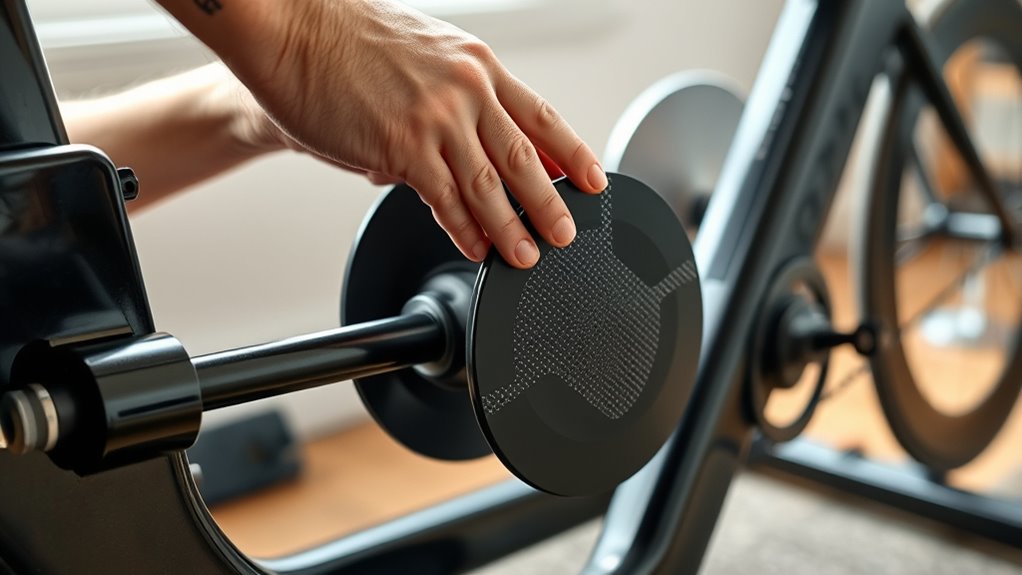
Following the manufacturer’s guidelines for routine servicing helps guarantee your trainer stays in top condition and functions accurately. Always consult the user manual for specific maintenance intervals, such as when to clean, lubricate, or inspect parts. Adhering to these schedules ensures peak performance and longevity. Use only manufacturer-approved replacement parts and lubricants to prevent damage and maintain warranty coverage. Regular calibration, as recommended, keeps your trainer’s metrics precise. Stay current with firmware updates, which often enhance functionality and fix bugs. Avoid attempting repairs yourself unless instructed by the manufacturer—unauthorized repairs can void your warranty. By following these guidelines, you ensure your indoor trainer operates smoothly, remains reliable, and provides accurate training data over time.
Frequently Asked Questions
How Do You Maintain an Indoor Trainer?
To maintain your indoor trainer, you should regularly wipe it down with a damp cloth to remove dust and sweat. Inspect and clean moving parts like belts and bearings monthly, checking for wear or damage. Keep cables and sensors clean and dry, and update firmware for peak performance. Store it in a dry, ventilated space and use covers or mats to protect against dust and moisture.
How to Do Maintenance on a Stationary Bike?
To maintain your stationary bike, start by wiping down the frame, handlebars, and console regularly to remove sweat and dust. Check and tighten bolts, fasteners, and handlebar tape monthly. Lubricate moving parts like pedals and chains every 4-6 weeks for smooth operation. Inspect resistance mechanisms, sensors, and electronic connections, cleaning or replacing as needed. Also, calibrate your bike periodically to guarantee it performs accurately and consistently.
Do Bike Trainers Need Maintenance?
Bike trainers do need regular maintenance to keep them performing perfectly. You should clean dust and sweat, inspect and replace belts, and check electrical connections consistently. Lubricating moving parts like bearings prevents corrosion, while calibrating and updating software keeps performance precise. Neglecting these tasks can cause overheating, wear, and reduced lifespan. Taking proactive, persistent, and proper care guarantees your trainer stays in top shape for every session.
How Can I Make My Indoor Trainer More Comfortable?
To make your indoor trainer more comfortable, start by using a supportive, well-padded saddle and handlebar grips to reduce pressure. Set up a fan or cooling system to keep you cool during workouts. Place your bike on a cushioned mat to dampen vibrations and noise. Adjust your saddle height and handlebar position for better ergonomics. Wear moisture-wicking clothes and use sweat guards to stay dry and comfortable.
Conclusion
Think of your indoor trainer as a delicate garden that needs regular tending. By keeping it clean, inspecting parts, and managing humidity, you’re nurturing its health. Just like a gardener tends to each plant to ensure a bountiful harvest, caring for your trainer guarantees smooth rides and longevity. Stay vigilant, follow maintenance tips, and your trainer will perform reliably, providing you with consistent, rewarding workouts—your personal, well-tended garden of progress.





